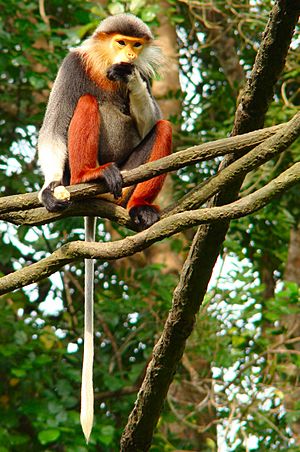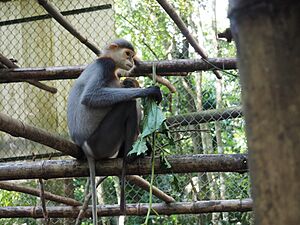Red-shanked douc facts for kids
Quick facts for kids Red-shanked douc |
|
|---|---|
 |
|
| Conservation status | |
| Scientific classification | |
| Genus: |
Pygathrix
|
| Species: |
nemaeus
|
 |
|
The red-shanked douc or red-shanked douc langur (Pygathrix nemaeus) is a colorful type of ape. It is known for its bright fur. These doucs live in forests in Vietnam and Cambodia.
Contents
What Do Red-Shanked Doucs Look Like?
Adult red-shanked doucs are about 61 to 76 centimeters (24-30 inches) tall. Their tails are also quite long, about 56 to 76 centimeters (22-30 inches). They usually weigh between 8 and 11 kilograms (18-24 pounds).
These doucs have black back legs that turn red from their knees down to their ankles. They have white hips, tails, and forearms. Their faces are a reddish-yellow color, and they have red and black stripes above their eyes.
Where Do Red-Shanked Doucs Live?
Red-shanked doucs live in the countries of Vietnam and Cambodia. They can be found high up in the mountains, sometimes as high as 2,000 meters (6,600 feet).
They live in different kinds of forests, including semi-deciduous forests and both primary and secondary rainforests. You'll usually find them living in the middle to upper parts of the forest canopy, which is like the "roof" of the forest made by tree branches and leaves.
Red-Shanked Douc Life Cycle
Female red-shanked doucs are ready to have babies when they are about 4 years old. Males are ready when they are 4 or 5 years old.
Before mating, red-shanked doucs do a special dance! They drop their jaws, wiggle their eyebrows, and shake their heads at each other. Scientists have noticed that the female douc usually starts this display. She lies down on a branch and looks back over her shoulder at the male. Sometimes he joins her, and sometimes he doesn't.
Red-shanked doucs usually have their babies between August and December. After being pregnant for 6 to 7 months, the mother gives birth to one baby. Newborn doucs are born with their eyes wide open and know how to hold onto their mothers right away.
Their fur and face colors slowly change as they grow. They get their adult colors when they are about 10 months old. Sometimes, adult doucs will even help feed and care for baby doucs who have lost their parents.
What Do Red-Shanked Doucs Eat?
Red-shanked doucs are active during the day. They mostly eat leaves that are high in fiber. They especially like to eat small, young, and soft leaves.
They also enjoy eating fruits like figs, as well as buds, flowers, bamboo shoots, and seeds. They eat from about 50 different types of plants. They do not eat any animals. They are known to eat peacefully together and even share their food with others in their group.
How Do Red-Shanked Doucs Behave?
Red-shanked doucs live in groups, usually with 4 to 15 family members. Each group has at least one male, and often about two females for every male. The males tend to be in charge of the group.
These doucs cannot grab things with their tails. Instead, they use their tails to help them balance as they move through the trees. They use their arms and legs to swing and climb through the forest, often following the same paths.
When a group travels, the adult males usually lead the way. The females and very young doucs stay in the middle, and the younger males follow at the back. If the doucs sense danger, they quietly escape through the trees. They spend most of their time eating, digesting their food, sleeping, and grooming each other's fur. They talk to each other using different facial expressions and sounds. A low growl can mean a threat, and a short, harsh squeal means they are in distress.
Threats to Red-Shanked Doucs
The red-shanked douc is in serious danger. In 2000, the IUCN Red List of Threatened Species said they were endangered. By 2020, they were listed as critically endangered because their numbers keep going down. They are also protected in Vietnam.
The biggest danger to red-shanked doucs is hunting. People hunt them for their meat, for traditional medicine, and to sell them to other countries. Local people sometimes hunt them for food, to keep as pets, or to make glue. Even though hunting them is against the law, the rules are not always strictly followed.
Other big threats include the pet trade, their forest homes being broken up into smaller pieces, and land being used for farming or military bases.
Laos has the largest number of red-shanked doucs, so protecting them in that country is very important.
Images for kids
-
A red-shanked douc at the Philadelphia Zoo
See also
 In Spanish: Duc de canillas rojas para niños
In Spanish: Duc de canillas rojas para niños








